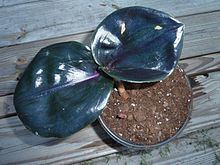Rank Species | ||
 | ||
Similar Geogenanthus, Geogenanthus poeppigii, Commelinaceae, Commelina | ||
Geogenanthus ciliatus is a flowering plant species in the family Commelinaceae (the dayflower & spiderwort family). As currently circumscribed, the genus Geogenanthus includes two other species, G. poeppigii and G. rhizanthus.
Contents
Etymology
The genus name, Geogenanthus is derived from the Greek geo meaning earth, gen meaning produce, and anthus meaning flower: thus, earth-borne flower. This genus was named for its flowers being borne from the base of the stem, appearing to grow from the ground. The specific epithet ciliatus is probably a reference to the flower petals of this species, which are fringed with small trichomes; that is, the petals are ciliate.
Distribution
Native to Upper Amazonia. It has been documented from the mid-elevation, eastern slopes of the Andes in Ecuador through the lowlands of northern Peru. It is typically found on the floor of primary rainforests.
Morphology
The aerial stems of this species are characterized by just one rotund, succulent leaf at the apex (occasionally there are two leaves on an aerial stem). Other species in the genus have 3 (less commonly 2) or more leaves in a terminal rosette. The top surface of the leaves are glossy and dark green, whereas the bottom of the leaves are velvety, dark-purple. The flowers are borne on long (up to 5 cm) pedicels in a single, or sometimes two, scorpioid cymes on a short peduncle arising from the basal node(s) of the aerial stem. Flowers have 3 green-brown sepals, 3 blue or purple petals fringed with moniliform tirchomes, 5-6 stamens, the three upper of which are bearded with moniliform hairs, and a single tricarpellate pistil.
Uses
This species is adaptable to a low light environments and it will occasionally appear as a house plant or conservatory plant in temperate climates. It also likes humidity and, in a pot, it should not be allowed to dry out for too long.
Horticulture
Sunlight that is bright as well as indirect is best. Plants do not flower or set seeds freely. For propagation the stem is cut and rooted.
